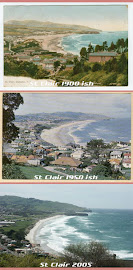From the Otago Daily Times website
The Dunedin City Council says it is looking at all options as it plans the defence of the city's most popular beaches from erosion caused by pounding Pacific waves. Study of the shape of sands to come A multimillion-dollar extension of the St Clair seawall as far as Lawyers Head, to protect St Kilda and Middle beaches, is among extreme "hard options" council staff say cannot be ruled out, while a host of "soft solutions" each come with their own problems. Council parks and reserves team leader Martin Thompson said yesterday a series of projects aimed at gathering data about the state of the three beaches was either finished, nearing completion or soon to start.
The work began in the months after a dramatic series of storms in 2007 caused significant erosion in the area - repeated when the storms returned last year - and threatened to send parts of Kettle Park crumbling into the sea. The projects launched in response included the work of two University of Otago students, who were conducting a monthly GPS survey, mapping the form and volume of sand on the beaches and how it changed over time. Also planned to start soon was a survey using ground-penetrating radar to locate the edges of the old landfill under Kettle Park, parts of which had been exposed by the severe storms in 2007, Mr Thompson said. The projects tied in with work already completed, including mapping the seafloor offshore from the beaches, ongoing monitoring of rip tides - which influenced erosion "hotspots" - and weather information from automated cameras at St Clair. Mr Thompson said the data would then be used in hydrodynamic computer modelling, mapping the impact of possible solutions - from a seawall extension to simply restocking the area with sand - on the beaches over a 50-year period. Other measures to be modelled included the construction of an offshore artificial reef, to dissipate the power of waves, he said. The modelling was expected to begin once the council established a new project team to co-ordinate the next stages of the work, possibly as soon as June this year, he said.
However, it could take the best part of a year to identify the preferred solutions and prepare a draft report recommending the best options to councillors, he said. The initiatives would then be presented for public consultation, and possibly become the subject of a resource consent hearing, meaning any construction could be several years away, he said. The data collection and modelling work had a budget of $335,000 for this year, but some of the possible solutions could be "quite expensive". Extending the St Clair seawall - considered an unlikely example, but one that could not be ruled out - was likely to cost "tens of millions of dollars" and raise significant aesthetic questions, he warned. "That would be a huge cost and maybe quite a structurally intrusive solution." Smaller "soft solutions", such as continually re-stocking the beaches with dredged sand, would be cheaper and less intrusive, but might mean "sacrificing" some vulnerable parts of the coastline to the sea, he said.
It was too soon to say what the likely measures taken would be, or what the exact cost could rise to. "We are not ruling anything out and we are not ruling anything in."In the meantime, the council had an annual budget of $400,000 to maintain a "holding pattern" of remedial work in the area, but the beaches remained vulnerable to further erosion in another series of big storms, he said. "We are at the mercy of the sea, basically, in terms of what sort of storm events we get . . . "If we get a run of storms again this year, we could be back in a situation where we are getting a lot of erosion."
Otago Daily Times
By Chris Morris on Fri, 16 Jan 2009
Large volumes of sand may have returned to Dunedin's most popular beaches, but the picture being painted by two University of Otago students may soon show if it is here to stay.
The pair, Teresa Konlechner and Charlotte Kidd, are engaged in a GPS survey of St Clair, St Kilda and Middle beaches, which aims to build a three-dimensional digital model showing the shape of sand deposits on the beaches.
The work is the latest in a series of monthly surveys undertaken by students, contracted to the Dunedin City Council, since last year's severe storms caused more erosion problems, stripping sand from the area.
And it's surprisingly tough work - the students cover up to 22km each day while taking up to 4000 measurements in the hot sun, and have survived close encounters with curious locals including, earlier this week, an angry sea lion and her young pup.read the rest of the article here
The surveys and investigations scheduled for Ocean Beach in 2008 are now complete.
A full topographical survey has been completed, together with a bathymetric survey. The automated Cam-eras are running, and the pictures from them should be available for viewing though the NIWA website. Tenders closed on 12 December for Hydrodynamic Modelling, which is the study into such elements as wave refraction, sediment transport, and the effect of storms on the beach. This will be part of the further research into the dynamics of the beach in the New Year.
There has also been good progress with a series of Focus Group meetings with the key stakeholders, and these will continue into 2009.
As these studies progress and the information base grows, the Council will continue to liaise with the Otago Regional Council and the Department of Conservation to identify the best solution for the Ocean Beach.
As previously advised, the results of these studies will form part of a draft plan for the Ocean Beach which will be fully consulted with the community before it is formally considered by the Council.
